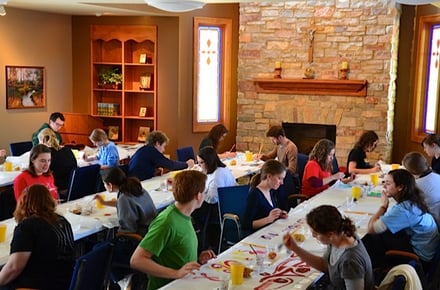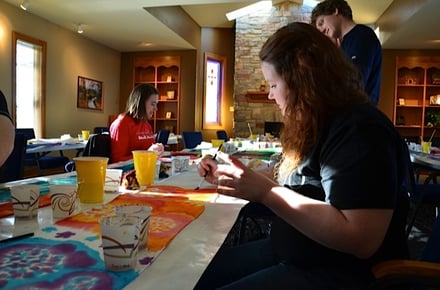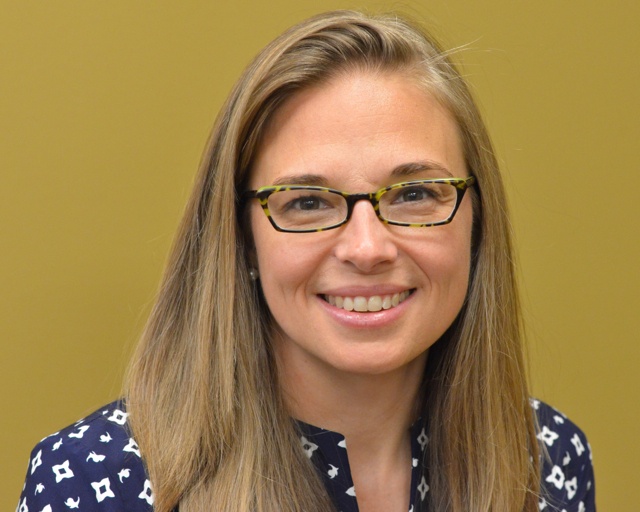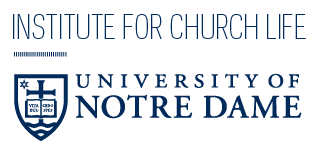I stopped writing cursive in the sixth grade. If I were to handwrite this sentence for you, you would likely find my penmanship immature, unrefined, and inefficient. Its unwieldy form and bubbly profile—adorned with loopty-loops and fancy curls—would sit fat, proud, and unapologetic upon the page, the way a toddler wears her protruding belly. Such is my cursive, hopelessly stuck in the grasp of my pre-adolescent hand. My painting, ceramic, and clarinet playing skills are also frozen in an earlier time. I have just recently acquired a loom and an easel, though not with any intention of “showing” my work. Suffice it to say, no one would call me an “artist.” And yet, my experience of fashioning retreats for Echo apprentice catechetical leaders over the last eight years has made it impossible for me to consider faith formation without also considering art.
“Art is not a thing; it is a way.”
—Elbert Hubbard
The art experiences that have become inherent to Echo formation retreats are not a professional cover to explore a personal hobby. They are not born of some grandiose idea to infuse faith formation with creative arts in a novel way. They are certainly not intended to give our Echo apprentices expertise in various artistic media, or as a means of creating symbolic expressions of their lives to shelve alongside other memorabilia. They are not employed as fun pedagogical tools to keep apprentices interested and awake, or as cruel exercises in humility for those haunted by the voice of their internal art critic, insisting that they will never get it right! No, these so-called “art experiences” are, quite simply, a way of doing what St. Irenaeus called “getting used to life with God.” They are a way of reminding ourselves that our lives are not our own. And frankly, I must admit that there was nothing intentional about them.
When I consider my own and perhaps our culture’s general disposition toward “art,” I find that the world is divided roughly into “artists” and “non-artists.” “Artists” are those who create. “Non-artists” witness what is created. Thank God for “artists,” whose courage to create moves, awakens, and inspires us. But this distance between “artists” and “non-artists” is problematic. For to what end are we “non-artists” inspired? To escape to another time and place? To understand ourselves and our experience more fully? To consider a different perspective? To admire artists? To become aware of our limitations as “non-artists”? None of these ends is necessarily bad. After all, an occasional escape can be refreshing. And it is true that we are not all capable of being professional artists.
Nonetheless, is not the courageous work of the “artist,” professional or otherwise, an invitation to “non-artists”—like me and perhaps you—to create and be created as well? If our lives are indeed deep and unfolding mysteries, labored works of art, cast and recast by God in fits and starts over many years by many hands, then the tasks of creating and of being created cannot simply be delegated to others to experience on our behalf. To forgo creating and being created would be to forgo becoming more “Real.”
“What is Real?” asked the Rabbit one day.
“It’s a thing that happens to you,” said the Skin Horse.
“It doesn’t happen all at once. You become. It takes a long time.”
“Does it hurt?” asked the Rabbit.
“Sometimes,” said the Skin Horse.
(Margery Williams, The Velveteen Rabbit)
I have never really liked the idea of a retreat as a time to “leave life behind and reconnect with God.” What good is reconnecting with God if the self and relationships we need transformed are left at the retreat door, only to be picked up again on the way out? Instead, we wanted to create a space within the Echo program in which apprentices would not “escape life” but rather plunge into its depths through the lens of faith. We wanted to create a space in which all of the disparate or dis-integrated parts of the apprentice’s lives could be gathered up and offered to Christ for the healing, transformation, and integration for which our lives are made. In 2004, Dr. Jan Poorman, the original architect and director of formation for Echo, and I began to develop a two-year, theologically based retreat program for the apprentices in our program. We spent long hours discussing systematic theology and the ways in which the Trinity and Paschal Mystery frame, inform, and transform the most dynamic and mundane dimensions of our lives and vocations.
 Integrated faith formation does not rely upon some general notion of transformation but rather on the specific transformation of our concrete and varied lives. Our hopes and identities are shaped by the stories and images that form the horizons of our imaginations. We wanted to invite the apprentices not only to learn theological precepts, but also to experience their personal and collective lives as part of the history of salvation and awaken to the ways in which the Christian mysteries are alive and unfolding within, around, and among us. In order to develop leaders who are led by the Spirit, we knew we must also help continue to shape our own theological imaginations and those of the apprentices. Our greatest task, then, was to offer the ideal conditions that might inspire the kind of vulnerability, malleability and trust that deep transformation requires. A lovely goal, perhaps, but how would we actually do this?
Integrated faith formation does not rely upon some general notion of transformation but rather on the specific transformation of our concrete and varied lives. Our hopes and identities are shaped by the stories and images that form the horizons of our imaginations. We wanted to invite the apprentices not only to learn theological precepts, but also to experience their personal and collective lives as part of the history of salvation and awaken to the ways in which the Christian mysteries are alive and unfolding within, around, and among us. In order to develop leaders who are led by the Spirit, we knew we must also help continue to shape our own theological imaginations and those of the apprentices. Our greatest task, then, was to offer the ideal conditions that might inspire the kind of vulnerability, malleability and trust that deep transformation requires. A lovely goal, perhaps, but how would we actually do this?
“The artist is always beginning.”
—Ezra Pound
As Jan and I met, she spoke of the transformative power of grace: freeing us from all that is not life-giving and of God, and freeing us for greater communion with our divided selves, creation, and God. As she spoke, images began to emerge in my mind: of charcoal drawings being splattered with shocking color; of ornately decorated wine glasses being shattered and strewn about the floor; of self-conscious figures beginning to move and dance in the dark; of organic ingredients being mingled to make bread; of stories being bound to other stories in a patchwork of once separated lives; and of hands patiently kneading a dense and resistant mound of clay. As Jan and I shared our respective insights, they seemed at once to inform and animate one another. My images found meaning in her words as her words found expression in my images.
Being freed from sin and freed for life by grace through the Holy Spirit were not just theological ideas to consider from a distance but realities to come to know and live. And there art was inserting itself as a way to explore these realities more deeply. And there I was, a bona fide “non-artist” compelled to create, to be created, and to invite others to do the same. Still, there was one small problem with this newly acquired artistic insight. I did not know how to do art or, for that matter, where to get charcoal. But perhaps that was the point. Eight years later (with the benefit of hindsight), it appears that my inexperience in creating was not a lack at all. Rather it provided and continues to provide a space in which fear, imagination, and hope are met by grace and together create something new. I, too, was an apprentice.
We have learned a great deal in the eight years since art invited itself into Echo’s formation program. And we are only beginning to understand and articulate how important art is to faith formation and the development of the theological imagination. Five fundamental insights that have emerged for me thus far are: 1) all art is an encounter; 2) encounters with Divine beauty transform us; 3) encounters with Divine beauty unify us; 4) art—as an encounter with Divine beauty that transforms and unifies us—is not a luxury in faith formation and the development of a theological imagination; it is an absolute necessity; and 5) all art requires courage.
1. “All art is an encounter.” —Rollo May
When a fresh ball of clay is set before the apprentices, their first question often is, “So, what are we going to make?” Our job is to remind them and ourselves that art in faith formation is not about making something; it is about experiencing an encounter that makes something of us. When the raw ball of clay, the blank screen, the empty stage, or the white canvas confronts us, we are not simply encountering the possibility within these media, but also the possibility within ourselves. For we are being asked not “who were you?” or “who are you?,” but rather “who will you become?” Art invites us to encounter our hopes and fears, the mysterious unknown, and the Spirit of God who transforms us into who we are not yet. In order to inspire and honor each art experience as an encounter with the Spirit of God, we, the facilitators of the experience, must attend to several practical matters:
a) context,
b) appropriate media,
c) process,
d) environment, and
e) getting out of the way.
Context
It is important to provide a theological, scriptural and spiritual context for any art experience. If we are engaged in art, not for its own sake, but rather as a way of “getting used to life with God,” then we must help the participants to situate this experience of creating and of being created within the Christian narrative and as an essential part of living a life of faith. As I mentioned earlier, our hope is not to become fluent in a variety of artistic media but to become fluent in what it means to belong to God. The more often we are given the chance to explore our personal and collective lives in light of the Paschal Mystery and the ongoing Christian narrative, the more likely we are to begin to see, understand, and live our lives through an implicitly cruciform lens.
Appropriate Media
We must choose media and theological, scriptural and spiritual contexts that animate one another. To use an obvious example, a reflection on King David dancing before the Lord with all his might is best animated by physical movement and dance, rather than seed planting or knitting. In developing art experiences, I have found that sometimes the medium emerges first and reveals the appropriate theological context, and at other times, the theological context emerges first and determines the particular medium to be used. In either case, it is important for the medium and context to connect to and inform each other.
Process
In addition to context and media, it is important to clarify what this art experience is and what it is not. This art experience is about encounter, not product. We are not art teachers offering artistic instruction. We are simply creating the conditions for an encounter with God through art. This means that we should never ask that a specific object be made, or provide examples of potential “finished products.” In Echo, we have found that when we ask apprentices to make a specific object, the encounter is obscured not only by the details involved in making that particular object but also by the mere idea that there should be a final “product”; and that we, as facilitators, know what that final product should look like. Instead, we invite the participants to explore the media itself (clay, paint brushes, paint, canvas, oil pastels, organic ingredients for cooking, chalk, their own bodies, words, music, soil, seeds, fabric, etc.) When necessary, we provide basic instruction on how to handle a given medium, such as how to wedge clay. The experience of encounter often emerges from simply engaging the medium itself and not from an involved demonstration of the “correct” way to manipulate it. As the participants engage the medium, they begin to trust it and allow it—rather than us—to guide them.
Environment
The invitation to engage in an art experience can elicit a variety of reactions. The chance to work with clay may evoke excitement to create; it may elicit frustration at having to get our hands dirty; it may trigger fear of failure left over from a traumatic art experience in elementary school; it may inspire feelings of inadequacy from not knowing what to do with the clay. Given the delicate nature of the art experience, it is important to provide a calm, comfortable, and safe space in which to work and to allow ample time to become familiar with and to explore the medium as a place to encounter not only our hopes and our fears, but also the Spirit of God who, as St. Paul reminds us, comes to help us in our weakness (cf. Rom 8:26).
Getting Out of the Way
As facilitators, we are not responsible for the encounter itself but have the responsibility to create the best conditions for an authentic encounter. Once we have attended to the elements listed above, we should get out of the way. In order to keep the focus on the experience and encounter and not the outcome, we should take care not to critique or capture the work as one might do of performance art. We should do our best to encourage the participants to stay engaged with the medium and to let it lead them.
2. Encounters with divine beauty transform us.
Authentic encounters can be scary. At times we may avoid them because they leave us vulnerable to the affects of the person or experience we encounter. Several years ago, the cover of The New Yorker depicted a young couple standing in an art museum before a large colorful piece of modern art. Their eyes are directed not at the artwork itself but rather at a 2” x 3” image of the piece they had just captured on their digital camera. This scene is familiar to us; when we see something beautiful or interesting, our first instinct is often to try to capture the image to take with us. But on another level, the scene is deeply ironic, as it illustrates our desire to capture beauty and contemplate it from a safe distance and on our own terms, rather than to encounter it firsthand and risk being captured by it. For beauty—which the Christian tradition often associates with the Divine—captures us, not the other way around. Once in her grasp, we no longer belong to ourselves, for we have entered that liminal state of grace in which we have ceased to be who we are and have not yet arrived at who we will become. Art, as an encounter with the Spirit of God, with Divine beauty, has the power to change us, which perhaps is why we are both drawn to it and frightened of it. And we have good reason to be frightened. Beauty—as Seamus Heaney reminds us in his poem entitled “Postscript”—can “catch the heart off guard and blow it open.”
 Our God is a God who catches our hearts off guard and blows them open. Getting used to life with God means getting used to a lifetime of having our hearts caught off guard and blown open again and again and again. Being caught off guard can be exciting, startling, unsettling, even terrifying. It can suspend our breath and cause our heart to abandon its rhythm. Being blown open can be exhilarating but it also can be painful, causing us suddenly to lose possession of all that we had held close, and leaving us empty, raw, vulnerable and exposed. But this loss of self is an essential part of transformation. As T.S. Eliot reminds us in Four Quartets:
Our God is a God who catches our hearts off guard and blows them open. Getting used to life with God means getting used to a lifetime of having our hearts caught off guard and blown open again and again and again. Being caught off guard can be exciting, startling, unsettling, even terrifying. It can suspend our breath and cause our heart to abandon its rhythm. Being blown open can be exhilarating but it also can be painful, causing us suddenly to lose possession of all that we had held close, and leaving us empty, raw, vulnerable and exposed. But this loss of self is an essential part of transformation. As T.S. Eliot reminds us in Four Quartets:
In order to arrive at what you are not
You must go through the way in which you are not.[1]
Sometimes apprentices become frustrated with their inability to express themselves in familiar ways using unfamiliar media. But this is precisely the point; to become someone new requires passing through the stages of disorientation, instability, and malleability that transformation requires. In seeking transformation, then, there may be nothing better than the terrifying and exhilarating act of creating in a foreign medium to bring us to the unsettling edge of our mysterious selves and keep going. This journey may sound romantic, but it is a dangerous path for those of us content to stay the same. The use of art in faith formation that I describe here is intended to move us beyond the safety of trying to capture or imitate pre-established notions of beauty or ourselves in our art, and instead allow us to be captured by God to become beauty as it is being born.
3. Encounters with divine beauty unite us.
W.H. Auden has argued that, “since art by its nature is a shared activity, it is the first to feel the consequences of a lack of common beliefs, and the first to seek a common basis for unity.”[2] If what Auden says is true, it is not surprising that art imposed itself on Echo’s formation program and on me in 2004. I was just making the transition from graduate school to full-time formation work and was aware not only of profound changes in my own life but also of the changing ecclesial culture in the Church and the growing divisions within and among generations of Catholics. In the midst of these divisions, I wondered about my ability to serve the apprentices and their more experienced parish mentors from around the country in ways that were familiar to me, meaningful for all of them, and relevant to the diverse Church we represented and served. While discursive approaches can be helpful in addressing and healing divisions at times, art—which often engages not only the mind, but also the body, the heart, and the soul—can unite the self, and that self with others and with God, in ways that even the most sophisticated and generous discourse cannot.
Tidy labels for ourselves, our friends, our ecclesial enemies, our Church, and our God, can be used to dismiss as often as they are used to acknowledge. The opportunity to create a space that disables easy labeling allows us to see and experience ourselves, one another, even God, in a new way. When apprentices engage in art experiences during Echo formation retreats, I cannot distinguish the progressive dancers from the conservative dancers, the scholarly potters from the pastoral potters, the peacenik painters from the papist ones, or the “really catholic” actors from those “not catholic enough.” And neither can they. Formation, or conforming ourselves to God, is not only about confirming who we are but also about risking becoming who we are not yet and allowing others to do the same. Art provides an encounter not only for the healing of the individual, but also for the healing and unity of our immediate communities, the Church, and the world.
4. Art is not a luxury in faith formation and the development of the theological imagination; it is a necessity.
Integrated faith formation is intended to inform believers about the faith, to help them situate their lives within the Christian mystery, and to fashion their lives by this mystery through an ongoing relationship with the person of Christ and the Church. Those of us who work in faith formation have a responsibility, then, to engage and cultivate our own theological imaginations and the imaginations of all believers and ministers entrusted to our care. Beauty, Kant suggests, “is experienced as a free, unresolved play between the understanding and the imagination.”[3] We will not be able to access Divine beauty if we engage theology as a purely cognitive exercise, or if we consider the imagination somehow dispensable or an add-on if time allows. Understanding—by the mind and the heart—and the imagination must be held together if we hope to preserve our already illusive relationship with Divine beauty. “Beauty will save the world,” Dostoevsky said. Art—with its unique ability to help us encounter Divine beauty and to be transformed and unified by it—must be considered an essential tool in programs of faith formation for all ages. Our relationship with God and the life of the Church depend on it. As Joseph Cardinal Ratzinger writes:
The Church is to transform, improve, “humanize” the world—but how can she do that if at the same time she turns her back on beauty, which is so closely allied to love? For together beauty and love form the true consolation in this world, bringing it as near as possible to the world of the resurrection.[4]
5. “All art requires courage.” —Anne Tucker
Engaging in the transformative art experience I have described above involves risking losing one’s self in order to be possessed and made new by the creative Spirit of God. As I mentioned earlier, this kind of transformation can be exhilarating as well as terrifying. Either way, it is clear that engaging in this dangerous art of becoming requires a great deal of courage. While others can invite us to practice this art, no one can do it for us. To all the “artists” who have the courage to create and to be created, thank you. To myself and other “non-artists” beckoned by the Spirit to create and to be created, corragio.
![]()
Editors’ Note: This essay originally appeared in Church Life: A Journal for the New Evangelization, volume 1, issue 2.
Featured Image: An Echo apprentice engages in an art experience while on retreat in LaPorte, Indiana. All photos in this essay courtesy of Echo Faith Formation Leadership Program.
[1] T. S. Eliot, Four Quartets: “East Coker” (New York: Harcourt, 1943), 29.
[2] W.H. Auden, “Criticism in a Mass Society” in The Intent of the Critic, ed. D.A. Stauffer (Princeton: Princeton University Press, 1941), 125.
[3] Susan Stewart, The Poet’s Freedom: A Notebook on Making (Chicago: The University of Chicago Press, 2011), 138.
[4] Joseph Ratzinger, The Feast of Faith (San Francisco: Ignatius Press, 1986), 126.



